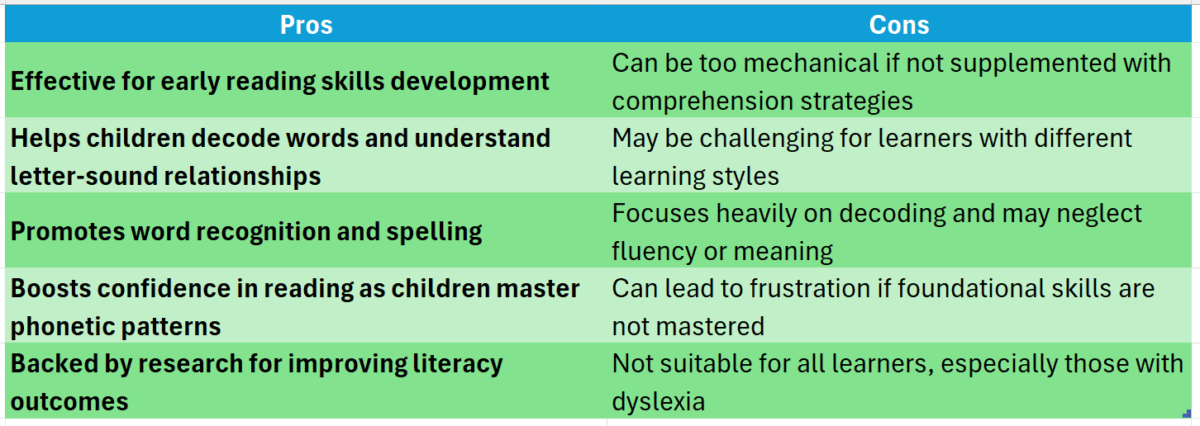
Phonics teaching is essential for helping young learners develop crucial reading skills. By emphasizing the connection between letters and sounds, phonics enables children to decode words effectively. This approach not only boosts their confidence but also nurtures a love for reading, making it a key element of early education.
Why Phonics Matters
Phonics instruction is vital as it equips children with the tools needed for independent reading. Key benefits include:
- Improved Decoding Skills: Children learn to sound out words, enhancing reading fluency.
- Stronger Vocabulary: Decoding words helps expand vocabulary and comprehension.
- Increased Confidence: Mastering phonics empowers children to tackle new texts with assurance.
Community-Based Instruction
Incorporating community-based instruction can further enrich phonics teaching. Engaging families and local resources fosters a supportive learning environment. For instance, reading groups in libraries or community centers offer additional practice and motivation, reinforcing phonics skills while building a community around literacy.
Curriculum and Instruction Strategies
To effectively implement phonics teaching, educators should consider these strategies:
- Structured Curriculum: A systematic curriculum helps children progress at their own pace.
- Interactive Activities: Games and hands-on activities make learning enjoyable.
- Regular Assessment: Frequent assessments track progress and identify areas needing support.
By focusing on these methods, we can harness the power of phonics teaching and pave the way for early reading success.
Study smarter, not harder—Enroll online today!
What Are the Most Effective Phonics Teaching Strategies?

Phonics teaching is essential for developing early reading skills. It helps children grasp the connection between letters and sounds, making reading easier and more enjoyable. Effective phonics strategies lay a strong foundation for lifelong literacy. Here are some of the best methods to enhance these skills.
Engaging Techniques for Phonics Teaching
- Interactive Games: Games like letter matching and sound scavenger hunts make learning fun and keep students engaged.
- Community-Based Instruction: Relating phonics lessons to real-life experiences, such as reading community signs, helps students understand the relevance of their learning.
Structured Curriculum and Instruction
- Systematic Approach: A logical sequence in teaching phonics, starting with simple sounds and moving to complex patterns, is crucial.
- Frequent Practice: Short, daily practice sessions reinforce skills and build confidence in young readers.
Phonics Games and Activities
- Rhyming Games: Finding rhyming words helps students recognize sound patterns.
- Sound Sorting: Sorting picture cards by beginning sounds reinforces phonemic awareness.
Visual Aids and Resources
- Flashcards: Using flashcards with letters and images enhances memory retention.
- Storybooks: Selecting books that emphasize phonics patterns strengthens understanding through reading aloud together.
Collaborative Learning
- Peer Teaching: Pairing students to teach phonics rules builds confidence.
- Group Activities: Engaging in group phonics games makes learning enjoyable and effective.
How Does Phonics Teaching Enhance Vocabulary Development?
Phonics teaching plays a crucial role in enhancing early reading skills, making it a vital part of any effective curriculum and instruction. By focusing on the sounds of letters and how they blend together, children can unlock the mysteries of reading. This foundational skill not only aids in decoding words but also enriches vocabulary development, setting the stage for lifelong learning.
The Connection Between Phonics and Vocabulary
Phonics teaching enhances vocabulary development in several ways:
- Sound Recognition: Children learn to recognize sounds, which helps them understand how words are formed.
- Word Building: By mastering phonics, kids can break down unfamiliar words into manageable parts, boosting their confidence.
- Reading Comprehension: As they read more, their vocabulary naturally expands, allowing them to grasp more complex texts.
Community-Based Instruction
Incorporating community-based instruction into phonics teaching can further enhance vocabulary. Engaging with local libraries, reading programs, or community events encourages children to practice their skills in real-world settings. This not only solidifies their learning but also makes reading a fun and social activity, reinforcing the importance of vocabulary in everyday life. By integrating phonics teaching with community resources, educators can create a rich learning environment. This approach not only improves early reading skills but also fosters a love for language, making vocabulary development an exciting journey for young learners.
The Role of Phonics in Building Strong Reading Foundations: Why It Matters
Phonics teaching is a crucial part of early reading skills development. It helps children connect sounds with letters, making reading less of a mystery and more of an adventure. By understanding phonics, kids can decode words, which is essential for their reading journey.
Why Phonics Teaching is Important
- Foundation for Reading: Phonics lays the groundwork for reading fluency. When children grasp the sounds of letters, they can read new words independently.
- Boosts Confidence: Mastering phonics gives kids the confidence to tackle books on their own. This confidence can lead to a lifelong love of reading.
- Supports Curriculum and Instruction: Effective phonics teaching aligns with educational standards, ensuring that children receive a comprehensive reading education.
Community-Based Instruction
Incorporating community-based instruction can enhance phonics teaching. Here’s how:
- Real-World Connections: Using local resources, like libraries or community centers, makes learning more relatable.
- Engagement: Involving families and community members in phonics activities encourages a supportive learning environment.
By focusing on phonics, we can build strong reading foundations for children, setting them up for success in school and beyond. It’s not just about reading; it’s about creating confident learners who are excited to explore the world through books!
Study smarter, not harder—Enroll online today!
Engaging Activities for Phonics Teaching: Making Learning Fun
Phonics teaching is essential for developing early reading skills. It helps children connect sounds with letters, making it easier for them to decode words. But how can we make this learning process enjoyable? Engaging activities can transform phonics lessons into fun experiences that children look forward to!
Interactive Games
- Sound Matching: Create a game where kids match pictures with the corresponding sounds. This reinforces their understanding of phonics in a playful way.
- Phonics Bingo: Use bingo cards with letters or sounds. As you call out sounds, children can mark them on their cards, making it a lively group activity.
Community-Based Instruction
Incorporating community-based instruction can enhance phonics teaching. For instance, visiting local libraries or bookstores can expose children to a variety of reading materials. This not only boosts their phonics skills but also fosters a love for reading.
Storytime with a Twist
Reading stories aloud is another fantastic method. Choose books that emphasize phonics patterns. Encourage children to identify sounds as you read, making them active participants in the story. This approach combines curriculum and instruction with fun, ensuring that learning feels natural and engaging.
How Can Scholarship.Education Support Your Phonics Teaching Journey?
Phonics teaching is essential for developing early reading skills. It helps children understand the relationship between letters and sounds, making it easier for them to decode words. But how can you enhance your phonics teaching journey? Let’s explore how Scholarship.Education can be your go-to resource.
At Scholarship.Education, we believe in the power of community-based instruction. By connecting with other educators, you can share experiences and strategies that work. This collaborative approach not only enriches your teaching methods but also fosters a supportive environment for both teachers and students.
Key Benefits of Community-Based Instruction:
- Shared Resources: Access a wealth of teaching materials and ideas.
- Peer Support: Get advice and encouragement from fellow educators.
- Diverse Perspectives: Learn different phonics teaching techniques that can enhance your curriculum and instruction. Another way Scholarship.Education supports your phonics teaching is through tailored curriculum and instruction resources. Our platform offers lesson plans, activities, and assessments designed specifically for phonics. This ensures that your students receive a well-rounded education that meets their needs.
Benefits of Tailored Curriculum and Instruction:
- Engaging Activities: Keep students interested with fun, interactive lessons.
- Progress Tracking: Easily monitor student progress and adjust instruction as needed.
- Flexibility: Adapt materials to fit different learning styles and paces, ensuring every child can succeed.
Measuring Progress: Assessing the Impact of Phonics Teaching on Reading Skills
Measuring the impact of phonics teaching on early reading skills is crucial for educators and parents alike. Understanding how well children are grasping phonics can help tailor instruction and ensure that every child is on the right path to becoming a confident reader. After all, reading is a fundamental skill that opens doors to knowledge and creativity!
Key Assessment Methods
To effectively measure progress in phonics teaching, consider these methods:
- Regular Reading Assessments: Conducting weekly or monthly reading tests can provide insights into a child’s phonics skills.
- Observational Assessments: Watching children as they read aloud can reveal their understanding of phonics in real-time.
- Community-Based Instruction: Engaging with local libraries or reading programs can enhance learning and provide additional support for students.
Benefits of Assessing Progress
Assessing phonics teaching not only helps in tracking progress but also:
- Identifies areas needing improvement.
- Encourages a supportive learning environment.
- Allows for adjustments in curriculum and instruction to better meet student needs.
By regularly measuring progress, educators can celebrate successes and address challenges promptly. This ongoing assessment ensures that phonics teaching remains effective, ultimately leading to improved reading skills and a lifelong love for reading. Remember, every child learns at their own pace, and with the right support, they can all thrive!
Study smarter, not harder—Enroll online today!
FAQs
1. What is phonics?
Phonics is a method of teaching reading by helping students connect letters with the sounds they make.
2. Why is phonics important in early reading?
Phonics helps children decode words, build fluency, and improve spelling by understanding sound-letter relationships.
3. At what age should phonics instruction begin?
Phonics is typically introduced around age 4–5, when children start recognizing letters and sounds.
4. How is phonics taught in the classroom?
Teachers use activities like sound matching, blending, segmenting, and word-building exercises to teach phonics skills.
5. What’s the difference between phonics and phonemic awareness?
Phonics involves letters and sounds, while phonemic awareness is the ability to hear and manipulate sounds in spoken words without letters.
6. Are there different types of phonics approaches?
Yes, including synthetic phonics, analytic phonics, analogy phonics, and embedded phonics. Each uses different strategies to teach decoding.





